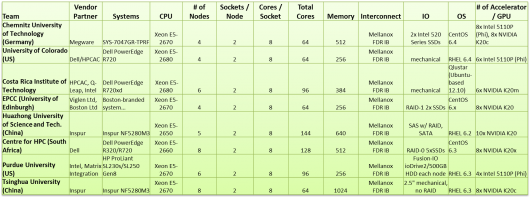(Click photo to enlarge.) The configurations for the ISC’13 Student Cluster Challenge have been released. Well, they were released a little earlier, but they needed to be verified to make sure that last-minute changes were accurately represented.
After eying the table, here are some points that jumped out at me:
- Accelerators Are Good Everyone is using accelerators this year, either NVIDIA GPUs or Intel Phi co-processors. We’ve seen accelerator use increase steadily since they made their first appearance in 2010. In that first year, teams using GPUs did “OK,” but their apps weren’t optimized to a large enough degree to get much benefit from them. But since 2011, the teams with the best results all used accelerators.
- How Much Is Too Much? Can you have too much of a good thing? Team Chemnitz has put this to the test with their “Coffee Table of Doom,” which is a brace of workstations. (I think four workstations are called a “brace,” right? Or is it a “pride?”) Each has FOUR accelerators. The team installed two Xeon Phi and two NVIDIA K20 cards in each box. One thing they found is that using all of them at once requires a lot of juice – well over the 3,000 watt limit.
- How Much Is Too Much 2? Team Tsinghua and Team South Africa both have more nodes (8) than any other competitor. Team Tsinghua maxed out their cluster memory with an astounding 1TB. The average system in the field (not including Tsinghua) sports a little over 400GB of RAM, so Tsinghua more than doubled that. I’ve always believed in the “more memory – more better” approach, but I’m a little less sure about having more nodes than the other teams. I could put together a mumbling, fumbling, and inarticulate argument either in favor of more nodes (reduced chance of I/O and interconnect contention) or against more nodes (higher electrical use to support extra chassis and interconnect).
I’ll be posting interviews with each team, as usual, and I’m going to ask them about their experiences with the GPUs and co-processors. Did they have any problems either getting or optimizing any of the applications? Or was it smooth sailing?
It also occurs to me that this competition is the first head-to-head Phi vs. Kepler battle. Students are running same applications on nearly the same hardware and have to contend with a 3,000 watt power cap. I don’t expect to see a clear-cut winner in this burgeoning Intel vs. NVIDIA war, but it will be interesting to check out the detailed results to see if there are any conclusions we can draw.
Posted In: Latest News, ISC 2013 Leipzig
Tagged: supercomputing, HPC, GPU, NVIDIA, ISC 2013, Intel, Student Cluster Challenge, accelerators, Phi, Kepler, Configurations


Pingback: GPUs Propel Underdog South Africa to Victory in Student Supercomputing Competition | Tech Info..
Pingback: GPUs Propel Underdog South Africa to Victory in Student Supercomputing Competition